Cross-Cultural Differences Analysis: Australia vs. Indonesia Report
VerifiedAdded on 2021/06/14
|12
|2662
|61
Report
AI Summary
This report provides a comprehensive analysis of the cross-cultural differences between Australia and Indonesia, focusing on the implications for international business and leadership. It begins with an executive summary highlighting the key cultural disparities, including individualism versus collectivism and power distance, and their impact on organizational culture. The report then delves into a detailed examination of these differences using Hofstede's model, providing specific examples and contrasting the cultural values of both countries. It explores the importance of adapting leadership and management styles to suit the local context. Finally, the report offers practical recommendations for Australian expatriate managers working in Indonesia, emphasizing the need for cultural sensitivity and the implementation of strategies that promote a productive work environment. The conclusion summarizes the findings and underscores the critical role of understanding cultural nuances for successful international expansion. This report is designed to help businesses navigate the complexities of operating in diverse cultural settings and promote effective cross-cultural communication and management.
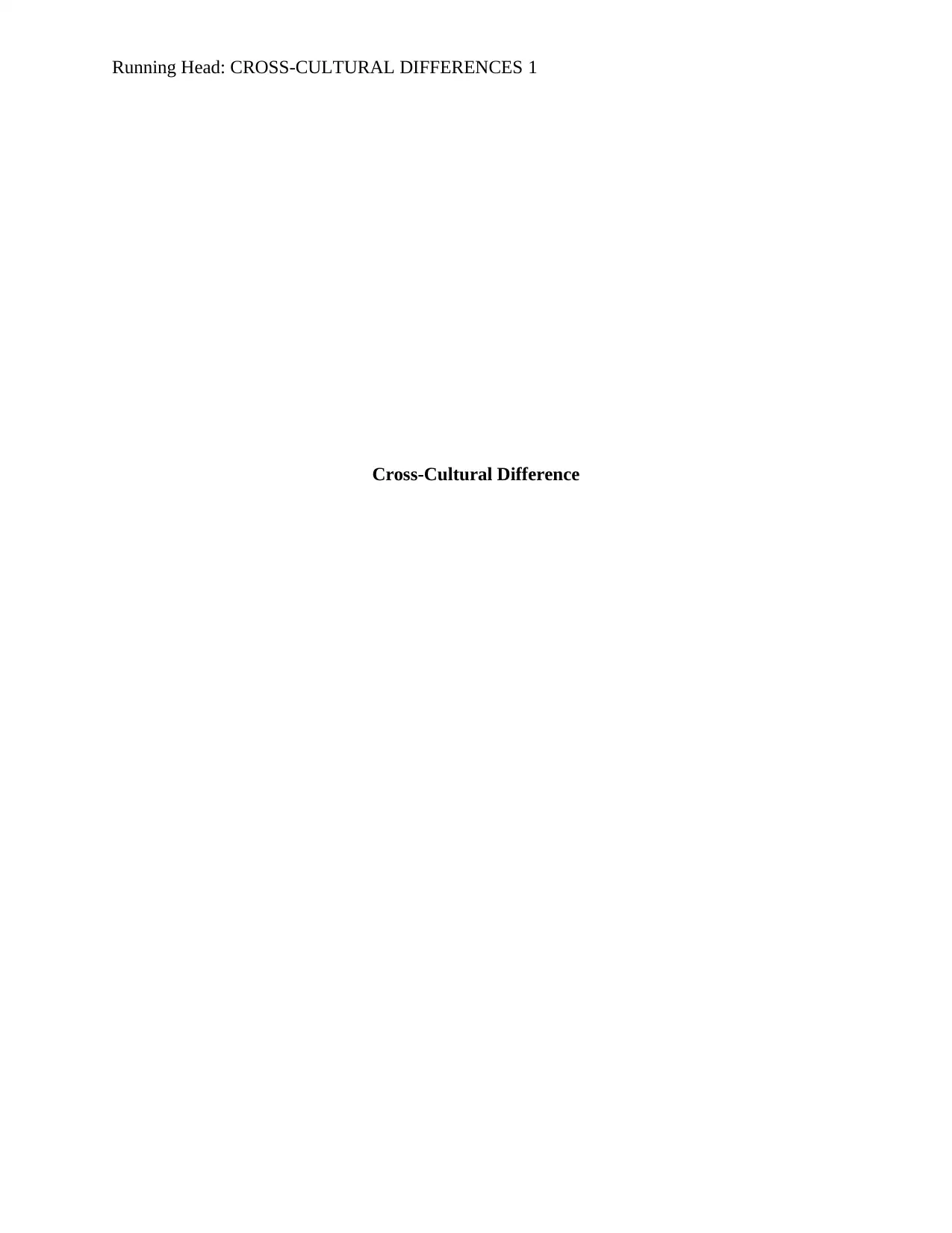
Running Head: CROSS-CULTURAL DIFFERENCES 1
Cross-Cultural Difference
Cross-Cultural Difference
Paraphrase This Document
Need a fresh take? Get an instant paraphrase of this document with our AI Paraphraser
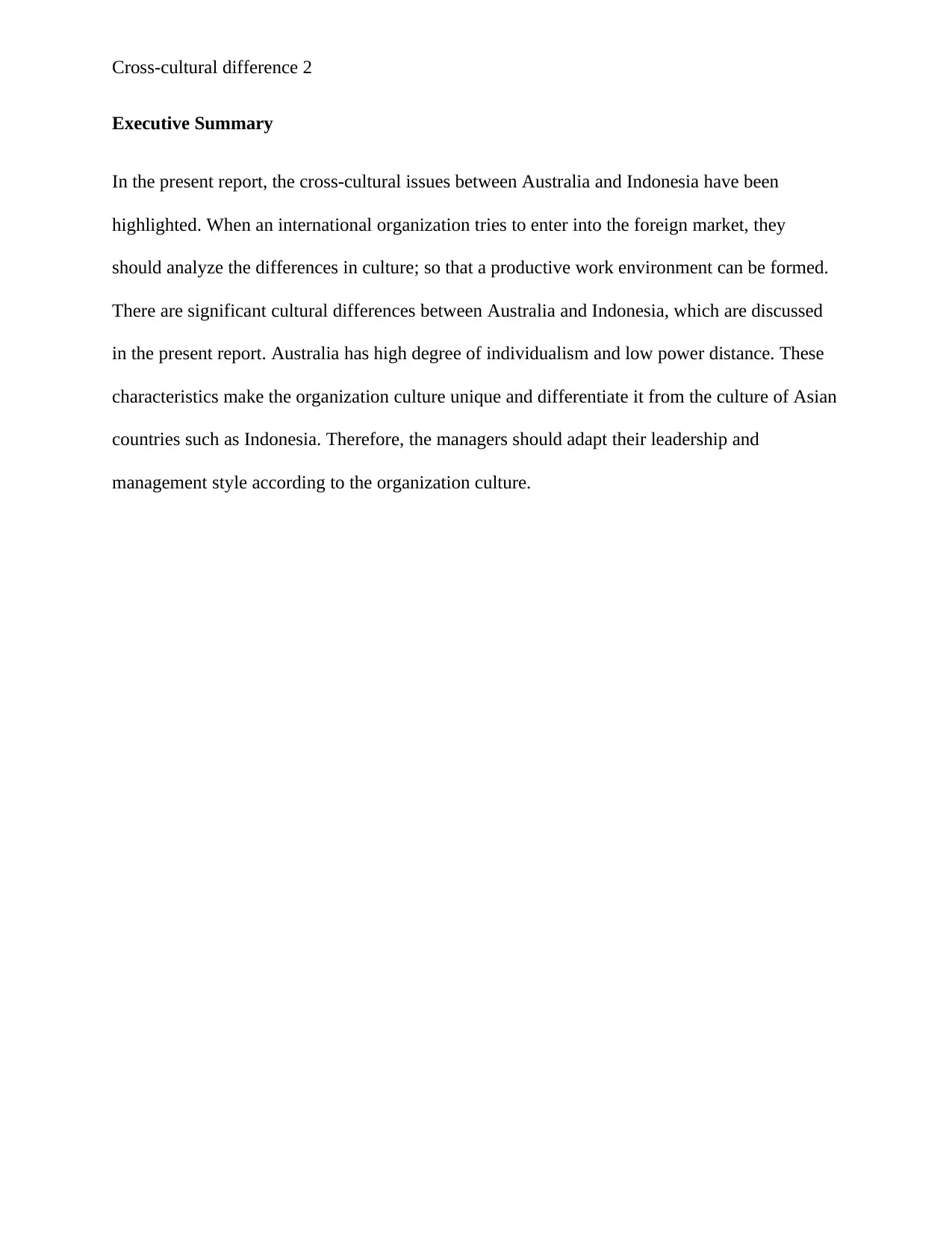
Cross-cultural difference 2
Executive Summary
In the present report, the cross-cultural issues between Australia and Indonesia have been
highlighted. When an international organization tries to enter into the foreign market, they
should analyze the differences in culture; so that a productive work environment can be formed.
There are significant cultural differences between Australia and Indonesia, which are discussed
in the present report. Australia has high degree of individualism and low power distance. These
characteristics make the organization culture unique and differentiate it from the culture of Asian
countries such as Indonesia. Therefore, the managers should adapt their leadership and
management style according to the organization culture.
Executive Summary
In the present report, the cross-cultural issues between Australia and Indonesia have been
highlighted. When an international organization tries to enter into the foreign market, they
should analyze the differences in culture; so that a productive work environment can be formed.
There are significant cultural differences between Australia and Indonesia, which are discussed
in the present report. Australia has high degree of individualism and low power distance. These
characteristics make the organization culture unique and differentiate it from the culture of Asian
countries such as Indonesia. Therefore, the managers should adapt their leadership and
management style according to the organization culture.
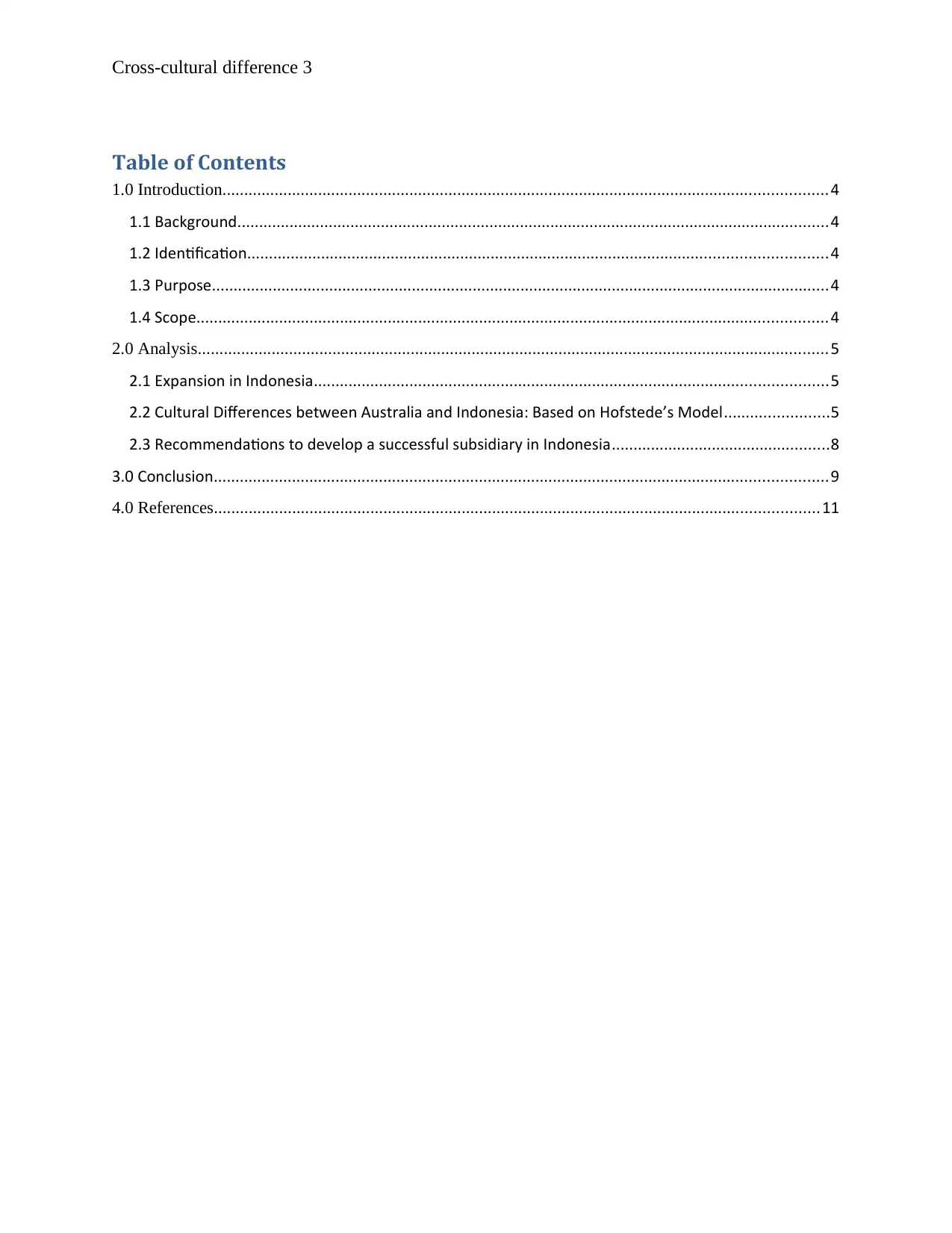
Cross-cultural difference 3
Table of Contents
1.0 Introduction...........................................................................................................................................4
1.1 Background........................................................................................................................................4
1.2 Identification.....................................................................................................................................4
1.3 Purpose..............................................................................................................................................4
1.4 Scope.................................................................................................................................................4
2.0 Analysis.................................................................................................................................................5
2.1 Expansion in Indonesia......................................................................................................................5
2.2 Cultural Differences between Australia and Indonesia: Based on Hofstede’s Model........................5
2.3 Recommendations to develop a successful subsidiary in Indonesia..................................................8
3.0 Conclusion.............................................................................................................................................9
4.0 References...........................................................................................................................................11
Table of Contents
1.0 Introduction...........................................................................................................................................4
1.1 Background........................................................................................................................................4
1.2 Identification.....................................................................................................................................4
1.3 Purpose..............................................................................................................................................4
1.4 Scope.................................................................................................................................................4
2.0 Analysis.................................................................................................................................................5
2.1 Expansion in Indonesia......................................................................................................................5
2.2 Cultural Differences between Australia and Indonesia: Based on Hofstede’s Model........................5
2.3 Recommendations to develop a successful subsidiary in Indonesia..................................................8
3.0 Conclusion.............................................................................................................................................9
4.0 References...........................................................................................................................................11
⊘ This is a preview!⊘
Do you want full access?
Subscribe today to unlock all pages.

Trusted by 1+ million students worldwide
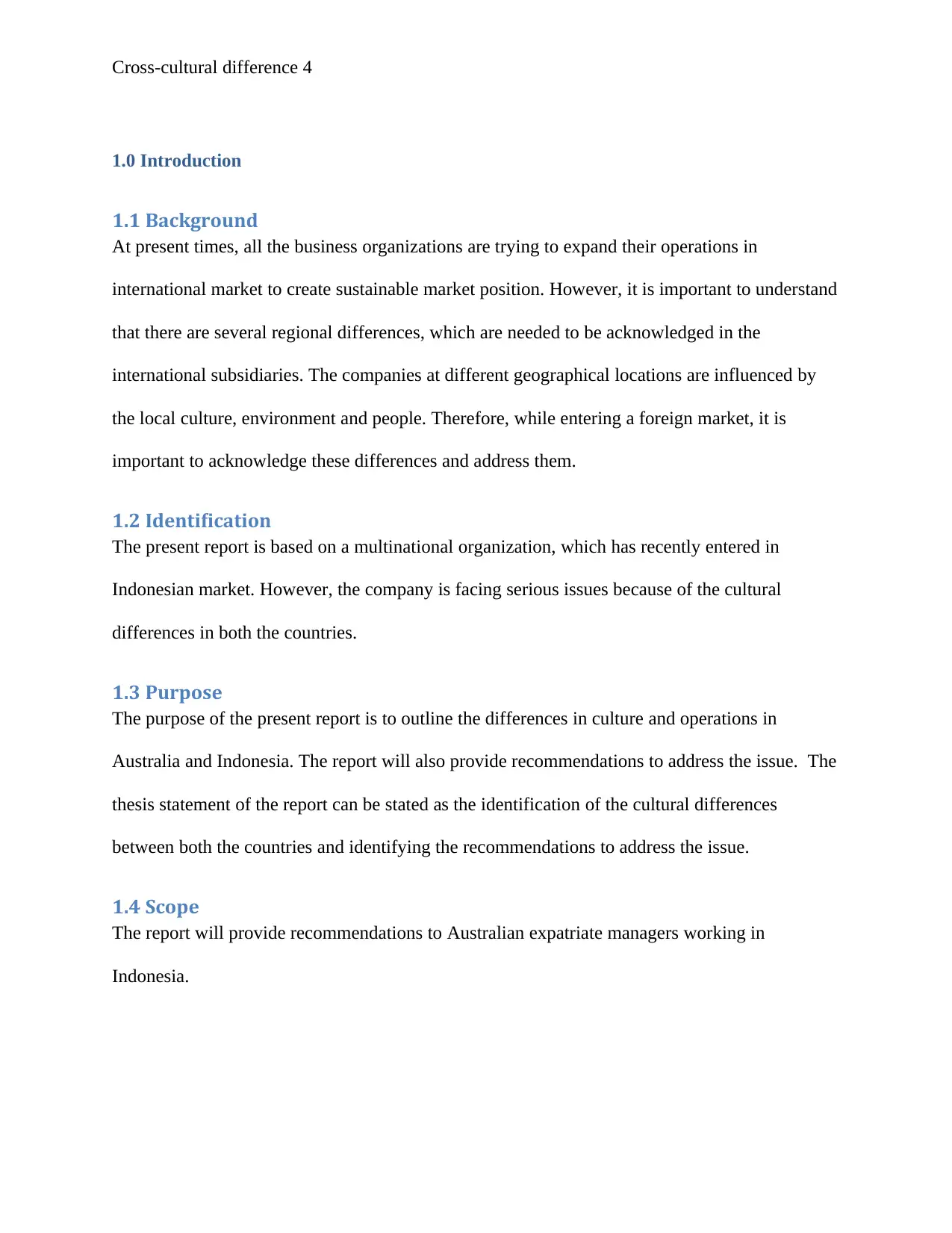
Cross-cultural difference 4
1.0 Introduction
1.1 Background
At present times, all the business organizations are trying to expand their operations in
international market to create sustainable market position. However, it is important to understand
that there are several regional differences, which are needed to be acknowledged in the
international subsidiaries. The companies at different geographical locations are influenced by
the local culture, environment and people. Therefore, while entering a foreign market, it is
important to acknowledge these differences and address them.
1.2 Identification
The present report is based on a multinational organization, which has recently entered in
Indonesian market. However, the company is facing serious issues because of the cultural
differences in both the countries.
1.3 Purpose
The purpose of the present report is to outline the differences in culture and operations in
Australia and Indonesia. The report will also provide recommendations to address the issue. The
thesis statement of the report can be stated as the identification of the cultural differences
between both the countries and identifying the recommendations to address the issue.
1.4 Scope
The report will provide recommendations to Australian expatriate managers working in
Indonesia.
1.0 Introduction
1.1 Background
At present times, all the business organizations are trying to expand their operations in
international market to create sustainable market position. However, it is important to understand
that there are several regional differences, which are needed to be acknowledged in the
international subsidiaries. The companies at different geographical locations are influenced by
the local culture, environment and people. Therefore, while entering a foreign market, it is
important to acknowledge these differences and address them.
1.2 Identification
The present report is based on a multinational organization, which has recently entered in
Indonesian market. However, the company is facing serious issues because of the cultural
differences in both the countries.
1.3 Purpose
The purpose of the present report is to outline the differences in culture and operations in
Australia and Indonesia. The report will also provide recommendations to address the issue. The
thesis statement of the report can be stated as the identification of the cultural differences
between both the countries and identifying the recommendations to address the issue.
1.4 Scope
The report will provide recommendations to Australian expatriate managers working in
Indonesia.
Paraphrase This Document
Need a fresh take? Get an instant paraphrase of this document with our AI Paraphraser
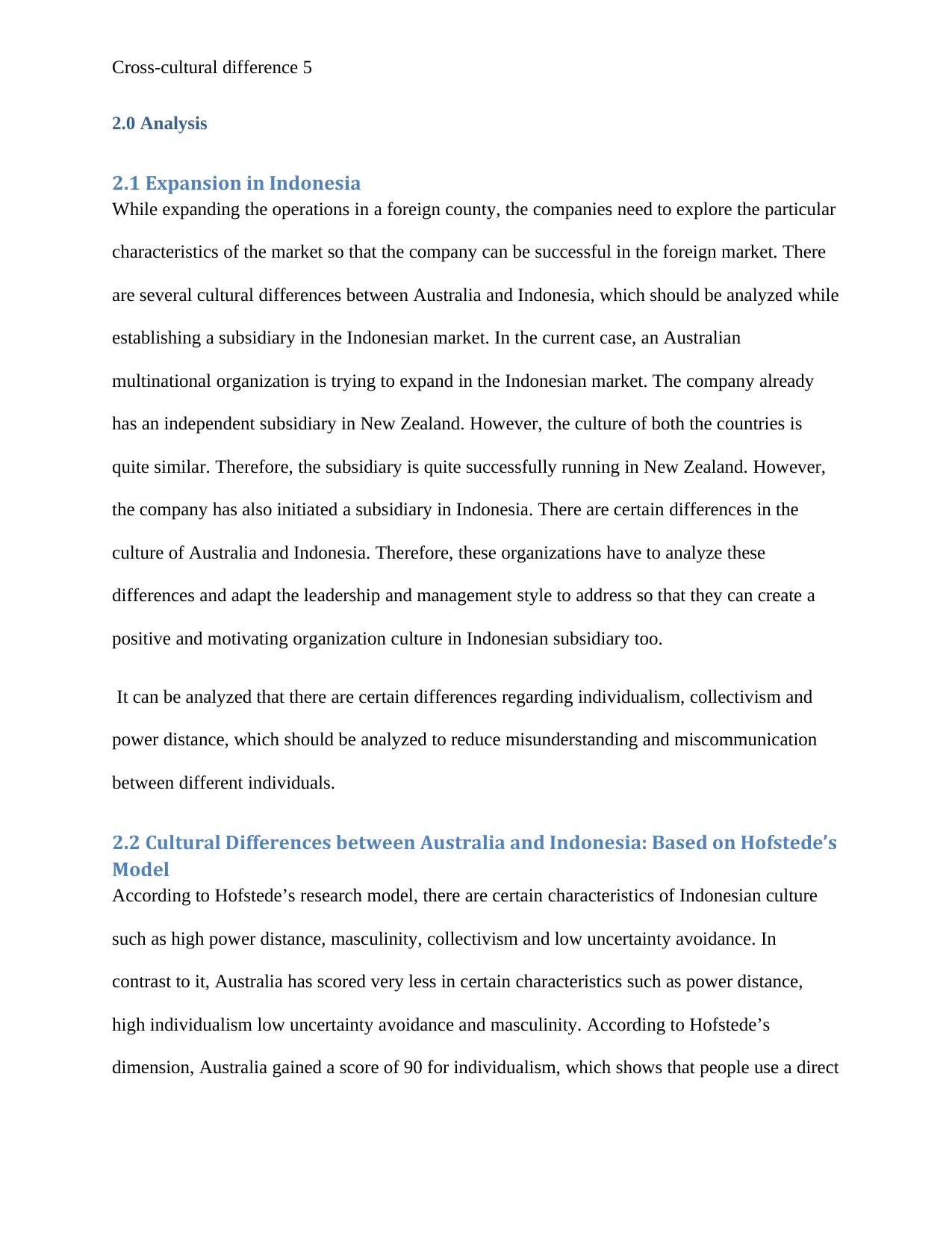
Cross-cultural difference 5
2.0 Analysis
2.1 Expansion in Indonesia
While expanding the operations in a foreign county, the companies need to explore the particular
characteristics of the market so that the company can be successful in the foreign market. There
are several cultural differences between Australia and Indonesia, which should be analyzed while
establishing a subsidiary in the Indonesian market. In the current case, an Australian
multinational organization is trying to expand in the Indonesian market. The company already
has an independent subsidiary in New Zealand. However, the culture of both the countries is
quite similar. Therefore, the subsidiary is quite successfully running in New Zealand. However,
the company has also initiated a subsidiary in Indonesia. There are certain differences in the
culture of Australia and Indonesia. Therefore, these organizations have to analyze these
differences and adapt the leadership and management style to address so that they can create a
positive and motivating organization culture in Indonesian subsidiary too.
It can be analyzed that there are certain differences regarding individualism, collectivism and
power distance, which should be analyzed to reduce misunderstanding and miscommunication
between different individuals.
2.2 Cultural Differences between Australia and Indonesia: Based on Hofstede’s
Model
According to Hofstede’s research model, there are certain characteristics of Indonesian culture
such as high power distance, masculinity, collectivism and low uncertainty avoidance. In
contrast to it, Australia has scored very less in certain characteristics such as power distance,
high individualism low uncertainty avoidance and masculinity. According to Hofstede’s
dimension, Australia gained a score of 90 for individualism, which shows that people use a direct
2.0 Analysis
2.1 Expansion in Indonesia
While expanding the operations in a foreign county, the companies need to explore the particular
characteristics of the market so that the company can be successful in the foreign market. There
are several cultural differences between Australia and Indonesia, which should be analyzed while
establishing a subsidiary in the Indonesian market. In the current case, an Australian
multinational organization is trying to expand in the Indonesian market. The company already
has an independent subsidiary in New Zealand. However, the culture of both the countries is
quite similar. Therefore, the subsidiary is quite successfully running in New Zealand. However,
the company has also initiated a subsidiary in Indonesia. There are certain differences in the
culture of Australia and Indonesia. Therefore, these organizations have to analyze these
differences and adapt the leadership and management style to address so that they can create a
positive and motivating organization culture in Indonesian subsidiary too.
It can be analyzed that there are certain differences regarding individualism, collectivism and
power distance, which should be analyzed to reduce misunderstanding and miscommunication
between different individuals.
2.2 Cultural Differences between Australia and Indonesia: Based on Hofstede’s
Model
According to Hofstede’s research model, there are certain characteristics of Indonesian culture
such as high power distance, masculinity, collectivism and low uncertainty avoidance. In
contrast to it, Australia has scored very less in certain characteristics such as power distance,
high individualism low uncertainty avoidance and masculinity. According to Hofstede’s
dimension, Australia gained a score of 90 for individualism, which shows that people use a direct
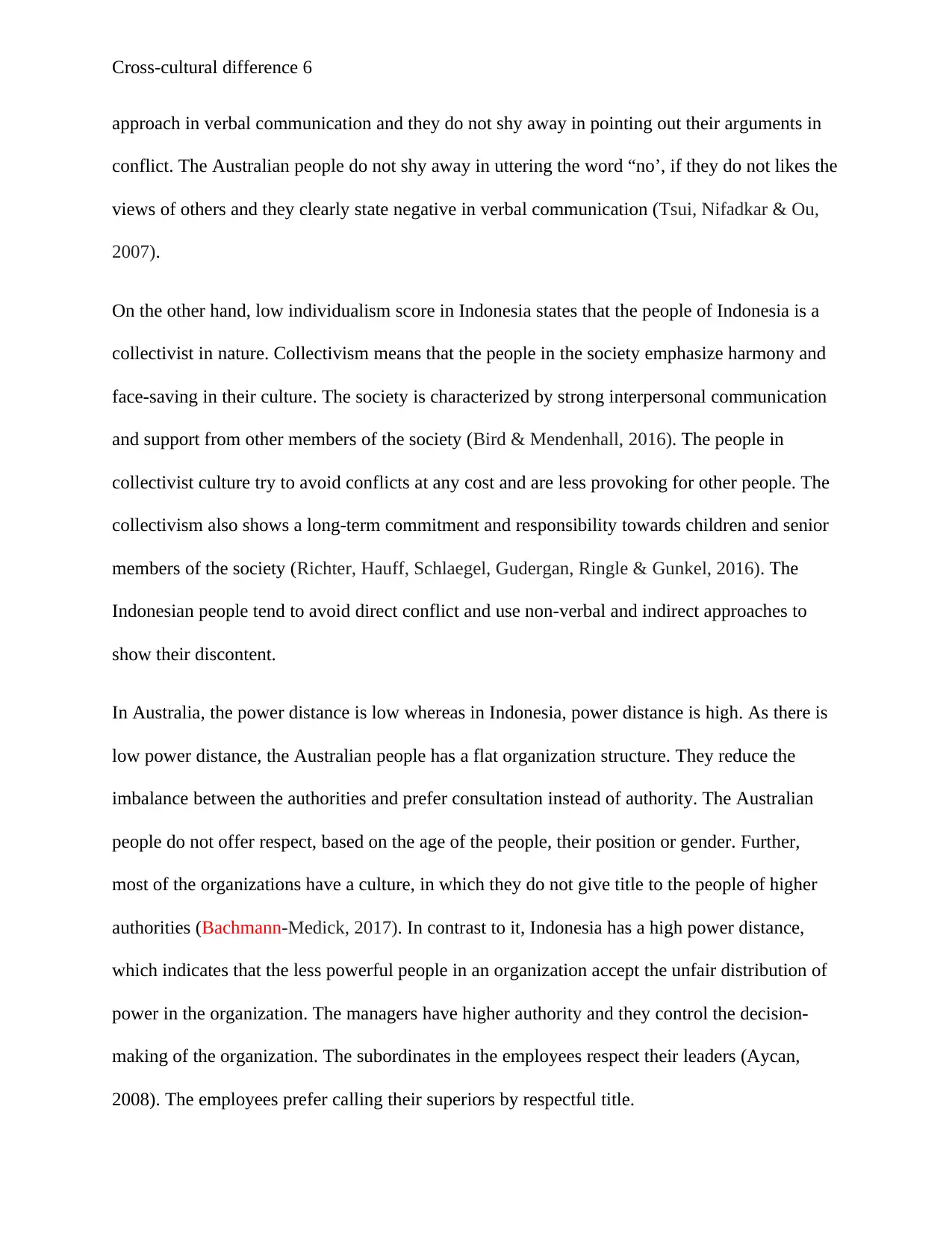
Cross-cultural difference 6
approach in verbal communication and they do not shy away in pointing out their arguments in
conflict. The Australian people do not shy away in uttering the word “no’, if they do not likes the
views of others and they clearly state negative in verbal communication (Tsui, Nifadkar & Ou,
2007).
On the other hand, low individualism score in Indonesia states that the people of Indonesia is a
collectivist in nature. Collectivism means that the people in the society emphasize harmony and
face-saving in their culture. The society is characterized by strong interpersonal communication
and support from other members of the society (Bird & Mendenhall, 2016). The people in
collectivist culture try to avoid conflicts at any cost and are less provoking for other people. The
collectivism also shows a long-term commitment and responsibility towards children and senior
members of the society (Richter, Hauff, Schlaegel, Gudergan, Ringle & Gunkel, 2016). The
Indonesian people tend to avoid direct conflict and use non-verbal and indirect approaches to
show their discontent.
In Australia, the power distance is low whereas in Indonesia, power distance is high. As there is
low power distance, the Australian people has a flat organization structure. They reduce the
imbalance between the authorities and prefer consultation instead of authority. The Australian
people do not offer respect, based on the age of the people, their position or gender. Further,
most of the organizations have a culture, in which they do not give title to the people of higher
authorities (Bachmann-Medick, 2017). In contrast to it, Indonesia has a high power distance,
which indicates that the less powerful people in an organization accept the unfair distribution of
power in the organization. The managers have higher authority and they control the decision-
making of the organization. The subordinates in the employees respect their leaders (Aycan,
2008). The employees prefer calling their superiors by respectful title.
approach in verbal communication and they do not shy away in pointing out their arguments in
conflict. The Australian people do not shy away in uttering the word “no’, if they do not likes the
views of others and they clearly state negative in verbal communication (Tsui, Nifadkar & Ou,
2007).
On the other hand, low individualism score in Indonesia states that the people of Indonesia is a
collectivist in nature. Collectivism means that the people in the society emphasize harmony and
face-saving in their culture. The society is characterized by strong interpersonal communication
and support from other members of the society (Bird & Mendenhall, 2016). The people in
collectivist culture try to avoid conflicts at any cost and are less provoking for other people. The
collectivism also shows a long-term commitment and responsibility towards children and senior
members of the society (Richter, Hauff, Schlaegel, Gudergan, Ringle & Gunkel, 2016). The
Indonesian people tend to avoid direct conflict and use non-verbal and indirect approaches to
show their discontent.
In Australia, the power distance is low whereas in Indonesia, power distance is high. As there is
low power distance, the Australian people has a flat organization structure. They reduce the
imbalance between the authorities and prefer consultation instead of authority. The Australian
people do not offer respect, based on the age of the people, their position or gender. Further,
most of the organizations have a culture, in which they do not give title to the people of higher
authorities (Bachmann-Medick, 2017). In contrast to it, Indonesia has a high power distance,
which indicates that the less powerful people in an organization accept the unfair distribution of
power in the organization. The managers have higher authority and they control the decision-
making of the organization. The subordinates in the employees respect their leaders (Aycan,
2008). The employees prefer calling their superiors by respectful title.
⊘ This is a preview!⊘
Do you want full access?
Subscribe today to unlock all pages.

Trusted by 1+ million students worldwide
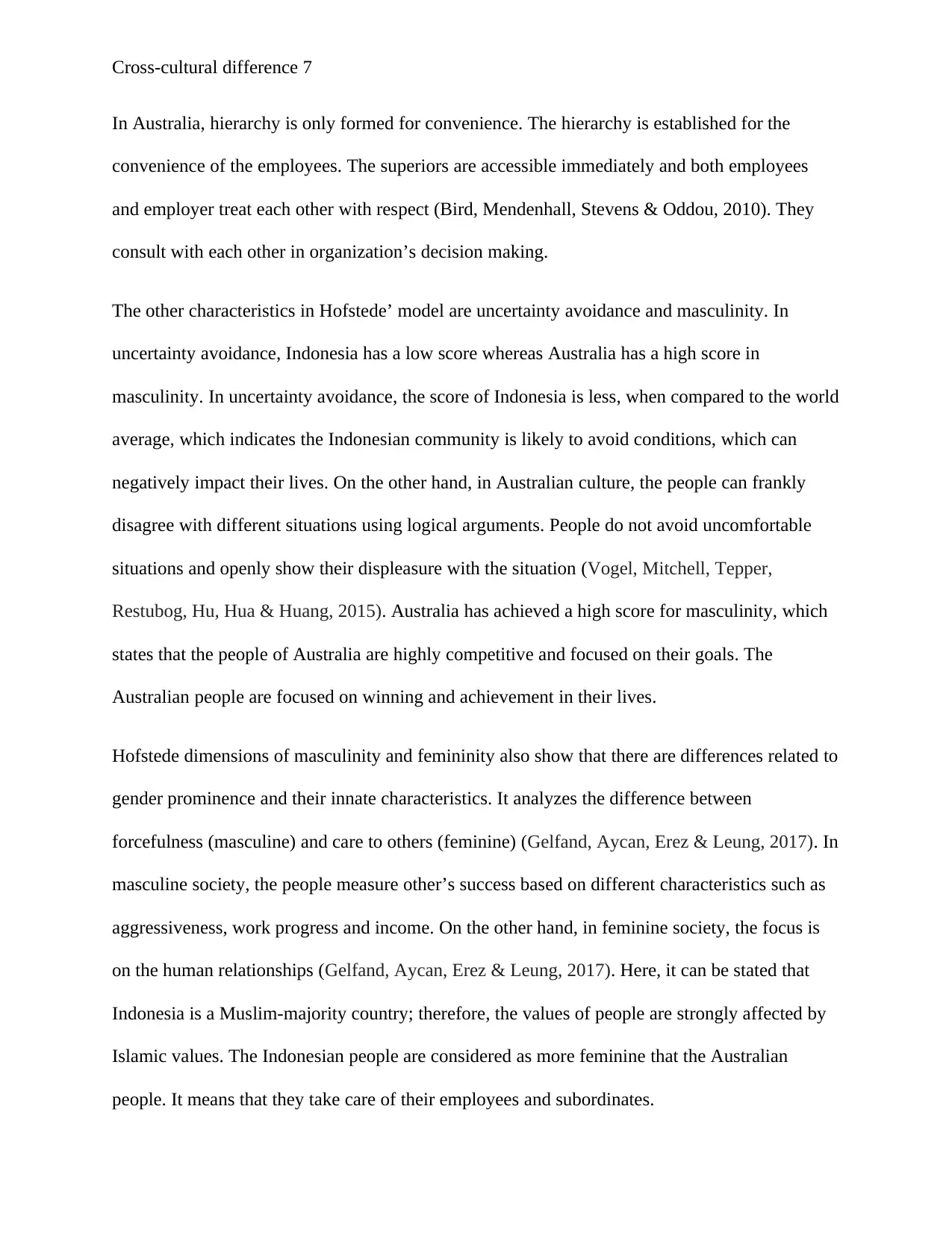
Cross-cultural difference 7
In Australia, hierarchy is only formed for convenience. The hierarchy is established for the
convenience of the employees. The superiors are accessible immediately and both employees
and employer treat each other with respect (Bird, Mendenhall, Stevens & Oddou, 2010). They
consult with each other in organization’s decision making.
The other characteristics in Hofstede’ model are uncertainty avoidance and masculinity. In
uncertainty avoidance, Indonesia has a low score whereas Australia has a high score in
masculinity. In uncertainty avoidance, the score of Indonesia is less, when compared to the world
average, which indicates the Indonesian community is likely to avoid conditions, which can
negatively impact their lives. On the other hand, in Australian culture, the people can frankly
disagree with different situations using logical arguments. People do not avoid uncomfortable
situations and openly show their displeasure with the situation (Vogel, Mitchell, Tepper,
Restubog, Hu, Hua & Huang, 2015). Australia has achieved a high score for masculinity, which
states that the people of Australia are highly competitive and focused on their goals. The
Australian people are focused on winning and achievement in their lives.
Hofstede dimensions of masculinity and femininity also show that there are differences related to
gender prominence and their innate characteristics. It analyzes the difference between
forcefulness (masculine) and care to others (feminine) (Gelfand, Aycan, Erez & Leung, 2017). In
masculine society, the people measure other’s success based on different characteristics such as
aggressiveness, work progress and income. On the other hand, in feminine society, the focus is
on the human relationships (Gelfand, Aycan, Erez & Leung, 2017). Here, it can be stated that
Indonesia is a Muslim-majority country; therefore, the values of people are strongly affected by
Islamic values. The Indonesian people are considered as more feminine that the Australian
people. It means that they take care of their employees and subordinates.
In Australia, hierarchy is only formed for convenience. The hierarchy is established for the
convenience of the employees. The superiors are accessible immediately and both employees
and employer treat each other with respect (Bird, Mendenhall, Stevens & Oddou, 2010). They
consult with each other in organization’s decision making.
The other characteristics in Hofstede’ model are uncertainty avoidance and masculinity. In
uncertainty avoidance, Indonesia has a low score whereas Australia has a high score in
masculinity. In uncertainty avoidance, the score of Indonesia is less, when compared to the world
average, which indicates the Indonesian community is likely to avoid conditions, which can
negatively impact their lives. On the other hand, in Australian culture, the people can frankly
disagree with different situations using logical arguments. People do not avoid uncomfortable
situations and openly show their displeasure with the situation (Vogel, Mitchell, Tepper,
Restubog, Hu, Hua & Huang, 2015). Australia has achieved a high score for masculinity, which
states that the people of Australia are highly competitive and focused on their goals. The
Australian people are focused on winning and achievement in their lives.
Hofstede dimensions of masculinity and femininity also show that there are differences related to
gender prominence and their innate characteristics. It analyzes the difference between
forcefulness (masculine) and care to others (feminine) (Gelfand, Aycan, Erez & Leung, 2017). In
masculine society, the people measure other’s success based on different characteristics such as
aggressiveness, work progress and income. On the other hand, in feminine society, the focus is
on the human relationships (Gelfand, Aycan, Erez & Leung, 2017). Here, it can be stated that
Indonesia is a Muslim-majority country; therefore, the values of people are strongly affected by
Islamic values. The Indonesian people are considered as more feminine that the Australian
people. It means that they take care of their employees and subordinates.
Paraphrase This Document
Need a fresh take? Get an instant paraphrase of this document with our AI Paraphraser
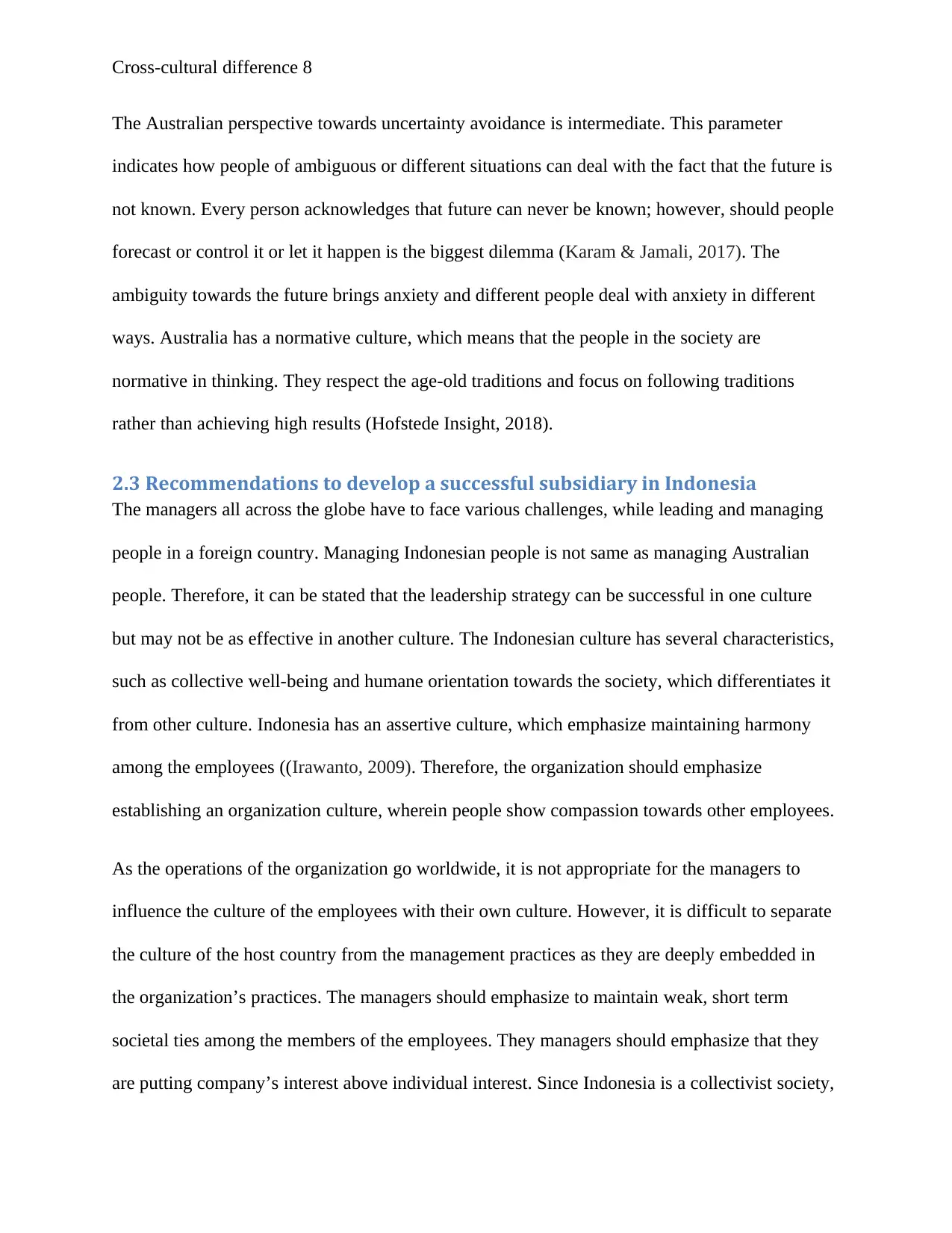
Cross-cultural difference 8
The Australian perspective towards uncertainty avoidance is intermediate. This parameter
indicates how people of ambiguous or different situations can deal with the fact that the future is
not known. Every person acknowledges that future can never be known; however, should people
forecast or control it or let it happen is the biggest dilemma (Karam & Jamali, 2017). The
ambiguity towards the future brings anxiety and different people deal with anxiety in different
ways. Australia has a normative culture, which means that the people in the society are
normative in thinking. They respect the age-old traditions and focus on following traditions
rather than achieving high results (Hofstede Insight, 2018).
2.3 Recommendations to develop a successful subsidiary in Indonesia
The managers all across the globe have to face various challenges, while leading and managing
people in a foreign country. Managing Indonesian people is not same as managing Australian
people. Therefore, it can be stated that the leadership strategy can be successful in one culture
but may not be as effective in another culture. The Indonesian culture has several characteristics,
such as collective well-being and humane orientation towards the society, which differentiates it
from other culture. Indonesia has an assertive culture, which emphasize maintaining harmony
among the employees ((Irawanto, 2009). Therefore, the organization should emphasize
establishing an organization culture, wherein people show compassion towards other employees.
As the operations of the organization go worldwide, it is not appropriate for the managers to
influence the culture of the employees with their own culture. However, it is difficult to separate
the culture of the host country from the management practices as they are deeply embedded in
the organization’s practices. The managers should emphasize to maintain weak, short term
societal ties among the members of the employees. They managers should emphasize that they
are putting company’s interest above individual interest. Since Indonesia is a collectivist society,
The Australian perspective towards uncertainty avoidance is intermediate. This parameter
indicates how people of ambiguous or different situations can deal with the fact that the future is
not known. Every person acknowledges that future can never be known; however, should people
forecast or control it or let it happen is the biggest dilemma (Karam & Jamali, 2017). The
ambiguity towards the future brings anxiety and different people deal with anxiety in different
ways. Australia has a normative culture, which means that the people in the society are
normative in thinking. They respect the age-old traditions and focus on following traditions
rather than achieving high results (Hofstede Insight, 2018).
2.3 Recommendations to develop a successful subsidiary in Indonesia
The managers all across the globe have to face various challenges, while leading and managing
people in a foreign country. Managing Indonesian people is not same as managing Australian
people. Therefore, it can be stated that the leadership strategy can be successful in one culture
but may not be as effective in another culture. The Indonesian culture has several characteristics,
such as collective well-being and humane orientation towards the society, which differentiates it
from other culture. Indonesia has an assertive culture, which emphasize maintaining harmony
among the employees ((Irawanto, 2009). Therefore, the organization should emphasize
establishing an organization culture, wherein people show compassion towards other employees.
As the operations of the organization go worldwide, it is not appropriate for the managers to
influence the culture of the employees with their own culture. However, it is difficult to separate
the culture of the host country from the management practices as they are deeply embedded in
the organization’s practices. The managers should emphasize to maintain weak, short term
societal ties among the members of the employees. They managers should emphasize that they
are putting company’s interest above individual interest. Since Indonesia is a collectivist society,
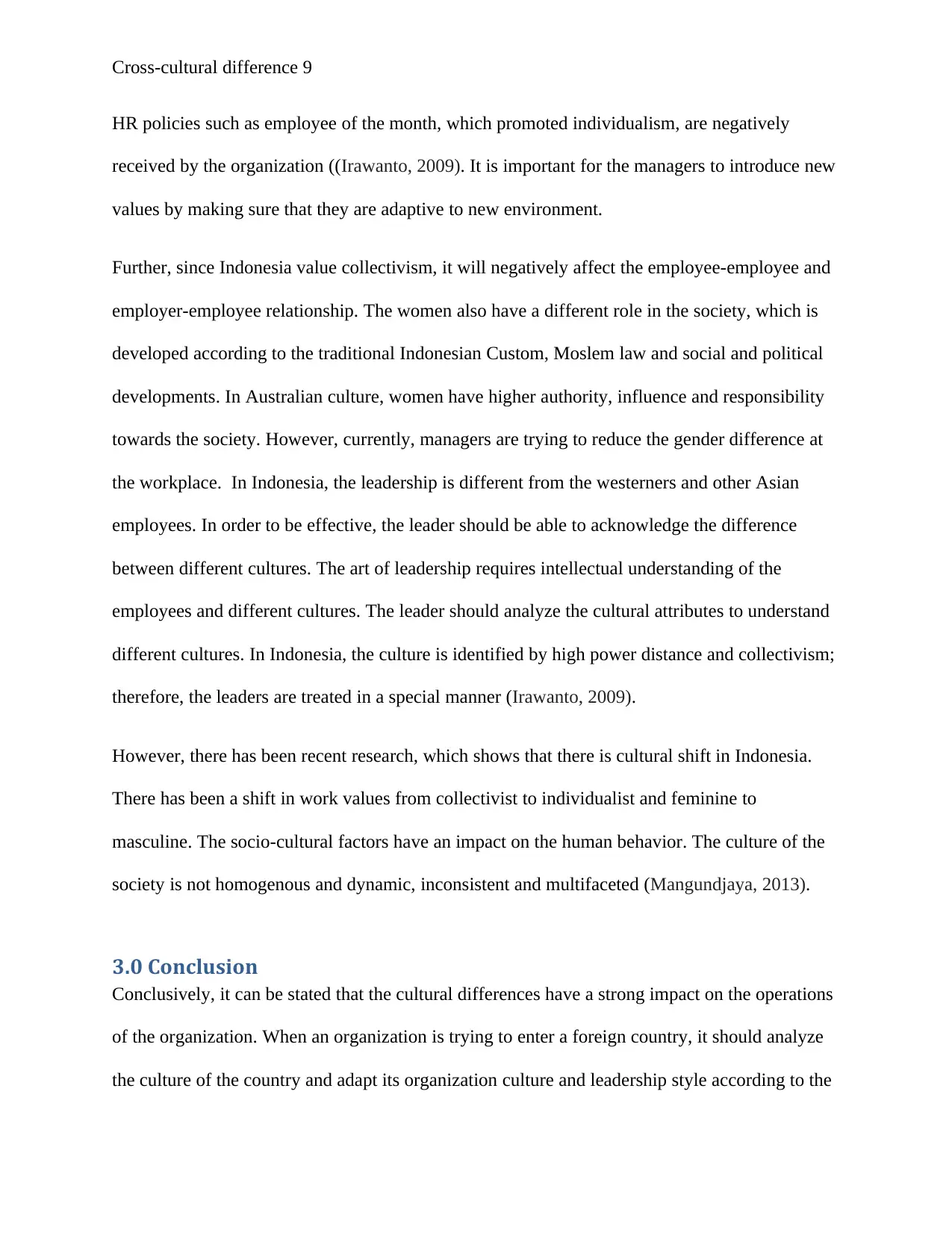
Cross-cultural difference 9
HR policies such as employee of the month, which promoted individualism, are negatively
received by the organization ((Irawanto, 2009). It is important for the managers to introduce new
values by making sure that they are adaptive to new environment.
Further, since Indonesia value collectivism, it will negatively affect the employee-employee and
employer-employee relationship. The women also have a different role in the society, which is
developed according to the traditional Indonesian Custom, Moslem law and social and political
developments. In Australian culture, women have higher authority, influence and responsibility
towards the society. However, currently, managers are trying to reduce the gender difference at
the workplace. In Indonesia, the leadership is different from the westerners and other Asian
employees. In order to be effective, the leader should be able to acknowledge the difference
between different cultures. The art of leadership requires intellectual understanding of the
employees and different cultures. The leader should analyze the cultural attributes to understand
different cultures. In Indonesia, the culture is identified by high power distance and collectivism;
therefore, the leaders are treated in a special manner (Irawanto, 2009).
However, there has been recent research, which shows that there is cultural shift in Indonesia.
There has been a shift in work values from collectivist to individualist and feminine to
masculine. The socio-cultural factors have an impact on the human behavior. The culture of the
society is not homogenous and dynamic, inconsistent and multifaceted (Mangundjaya, 2013).
3.0 Conclusion
Conclusively, it can be stated that the cultural differences have a strong impact on the operations
of the organization. When an organization is trying to enter a foreign country, it should analyze
the culture of the country and adapt its organization culture and leadership style according to the
HR policies such as employee of the month, which promoted individualism, are negatively
received by the organization ((Irawanto, 2009). It is important for the managers to introduce new
values by making sure that they are adaptive to new environment.
Further, since Indonesia value collectivism, it will negatively affect the employee-employee and
employer-employee relationship. The women also have a different role in the society, which is
developed according to the traditional Indonesian Custom, Moslem law and social and political
developments. In Australian culture, women have higher authority, influence and responsibility
towards the society. However, currently, managers are trying to reduce the gender difference at
the workplace. In Indonesia, the leadership is different from the westerners and other Asian
employees. In order to be effective, the leader should be able to acknowledge the difference
between different cultures. The art of leadership requires intellectual understanding of the
employees and different cultures. The leader should analyze the cultural attributes to understand
different cultures. In Indonesia, the culture is identified by high power distance and collectivism;
therefore, the leaders are treated in a special manner (Irawanto, 2009).
However, there has been recent research, which shows that there is cultural shift in Indonesia.
There has been a shift in work values from collectivist to individualist and feminine to
masculine. The socio-cultural factors have an impact on the human behavior. The culture of the
society is not homogenous and dynamic, inconsistent and multifaceted (Mangundjaya, 2013).
3.0 Conclusion
Conclusively, it can be stated that the cultural differences have a strong impact on the operations
of the organization. When an organization is trying to enter a foreign country, it should analyze
the culture of the country and adapt its organization culture and leadership style according to the
⊘ This is a preview!⊘
Do you want full access?
Subscribe today to unlock all pages.

Trusted by 1+ million students worldwide

Cross-cultural difference 10
native culture. In the present case study, An Australian organization is trying to expand in
Indonesia. The company already has an independent subsidiary in New Zealand. However, in
order to enter the foreign market of Indonesia, the company has to analyze the cultural
characteristics of both the countries. The Indonesian culture is characterized by high collectivism
and feminism. It means that the employer and the employees behave like a family and work
together for the organization goals. The culture does not thrive for individual success.
native culture. In the present case study, An Australian organization is trying to expand in
Indonesia. The company already has an independent subsidiary in New Zealand. However, in
order to enter the foreign market of Indonesia, the company has to analyze the cultural
characteristics of both the countries. The Indonesian culture is characterized by high collectivism
and feminism. It means that the employer and the employees behave like a family and work
together for the organization goals. The culture does not thrive for individual success.
Paraphrase This Document
Need a fresh take? Get an instant paraphrase of this document with our AI Paraphraser
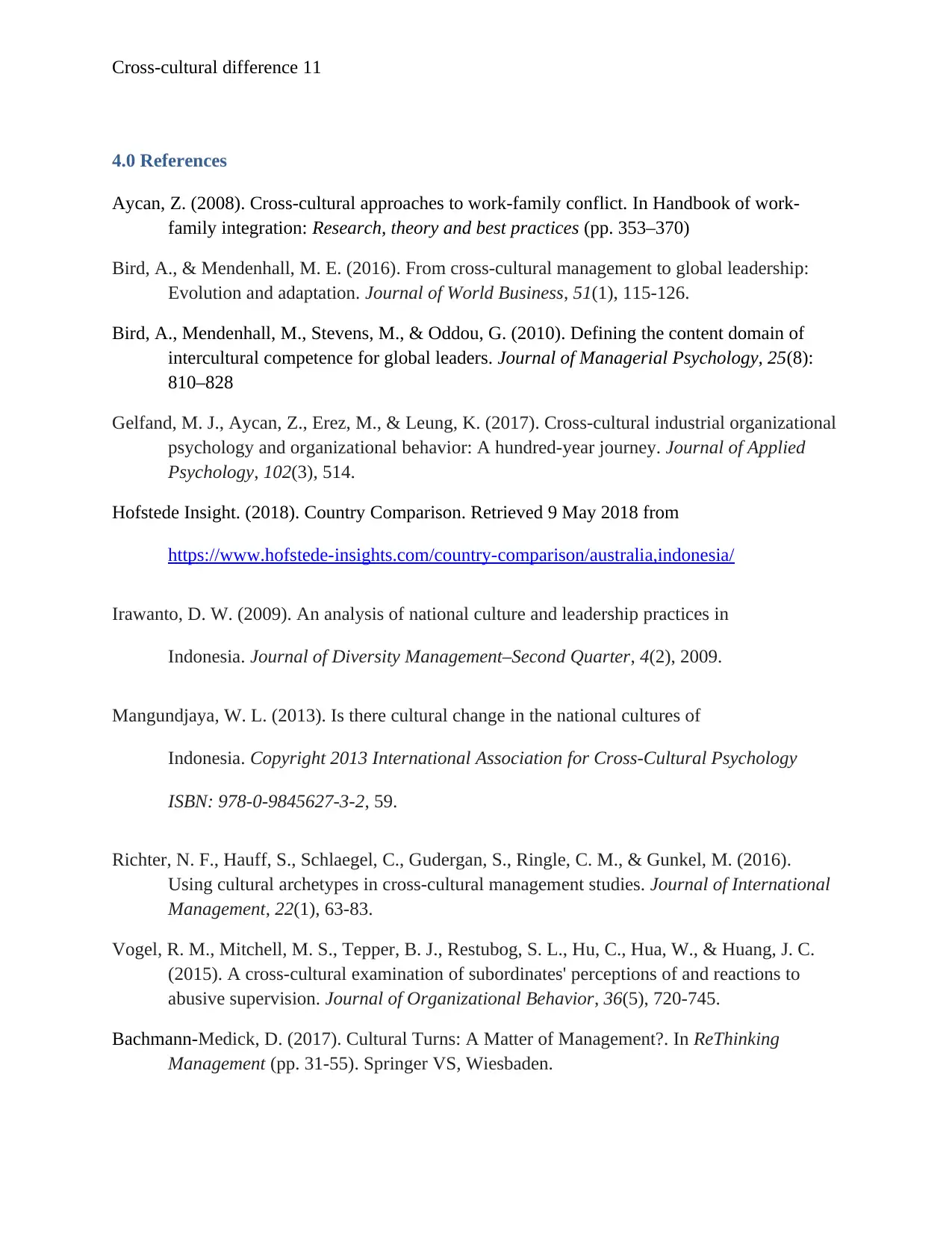
Cross-cultural difference 11
4.0 References
Aycan, Z. (2008). Cross-cultural approaches to work-family conflict. In Handbook of work-
family integration: Research, theory and best practices (pp. 353–370)
Bird, A., & Mendenhall, M. E. (2016). From cross-cultural management to global leadership:
Evolution and adaptation. Journal of World Business, 51(1), 115-126.
Bird, A., Mendenhall, M., Stevens, M., & Oddou, G. (2010). Defining the content domain of
intercultural competence for global leaders. Journal of Managerial Psychology, 25(8):
810–828
Gelfand, M. J., Aycan, Z., Erez, M., & Leung, K. (2017). Cross-cultural industrial organizational
psychology and organizational behavior: A hundred-year journey. Journal of Applied
Psychology, 102(3), 514.
Hofstede Insight. (2018). Country Comparison. Retrieved 9 May 2018 from
https://www.hofstede-insights.com/country-comparison/australia,indonesia/
Irawanto, D. W. (2009). An analysis of national culture and leadership practices in
Indonesia. Journal of Diversity Management–Second Quarter, 4(2), 2009.
Mangundjaya, W. L. (2013). Is there cultural change in the national cultures of
Indonesia. Copyright 2013 International Association for Cross-Cultural Psychology
ISBN: 978-0-9845627-3-2, 59.
Richter, N. F., Hauff, S., Schlaegel, C., Gudergan, S., Ringle, C. M., & Gunkel, M. (2016).
Using cultural archetypes in cross-cultural management studies. Journal of International
Management, 22(1), 63-83.
Vogel, R. M., Mitchell, M. S., Tepper, B. J., Restubog, S. L., Hu, C., Hua, W., & Huang, J. C.
(2015). A cross‐cultural examination of subordinates' perceptions of and reactions to
abusive supervision. Journal of Organizational Behavior, 36(5), 720-745.
Bachmann-Medick, D. (2017). Cultural Turns: A Matter of Management?. In ReThinking
Management (pp. 31-55). Springer VS, Wiesbaden.
4.0 References
Aycan, Z. (2008). Cross-cultural approaches to work-family conflict. In Handbook of work-
family integration: Research, theory and best practices (pp. 353–370)
Bird, A., & Mendenhall, M. E. (2016). From cross-cultural management to global leadership:
Evolution and adaptation. Journal of World Business, 51(1), 115-126.
Bird, A., Mendenhall, M., Stevens, M., & Oddou, G. (2010). Defining the content domain of
intercultural competence for global leaders. Journal of Managerial Psychology, 25(8):
810–828
Gelfand, M. J., Aycan, Z., Erez, M., & Leung, K. (2017). Cross-cultural industrial organizational
psychology and organizational behavior: A hundred-year journey. Journal of Applied
Psychology, 102(3), 514.
Hofstede Insight. (2018). Country Comparison. Retrieved 9 May 2018 from
https://www.hofstede-insights.com/country-comparison/australia,indonesia/
Irawanto, D. W. (2009). An analysis of national culture and leadership practices in
Indonesia. Journal of Diversity Management–Second Quarter, 4(2), 2009.
Mangundjaya, W. L. (2013). Is there cultural change in the national cultures of
Indonesia. Copyright 2013 International Association for Cross-Cultural Psychology
ISBN: 978-0-9845627-3-2, 59.
Richter, N. F., Hauff, S., Schlaegel, C., Gudergan, S., Ringle, C. M., & Gunkel, M. (2016).
Using cultural archetypes in cross-cultural management studies. Journal of International
Management, 22(1), 63-83.
Vogel, R. M., Mitchell, M. S., Tepper, B. J., Restubog, S. L., Hu, C., Hua, W., & Huang, J. C.
(2015). A cross‐cultural examination of subordinates' perceptions of and reactions to
abusive supervision. Journal of Organizational Behavior, 36(5), 720-745.
Bachmann-Medick, D. (2017). Cultural Turns: A Matter of Management?. In ReThinking
Management (pp. 31-55). Springer VS, Wiesbaden.
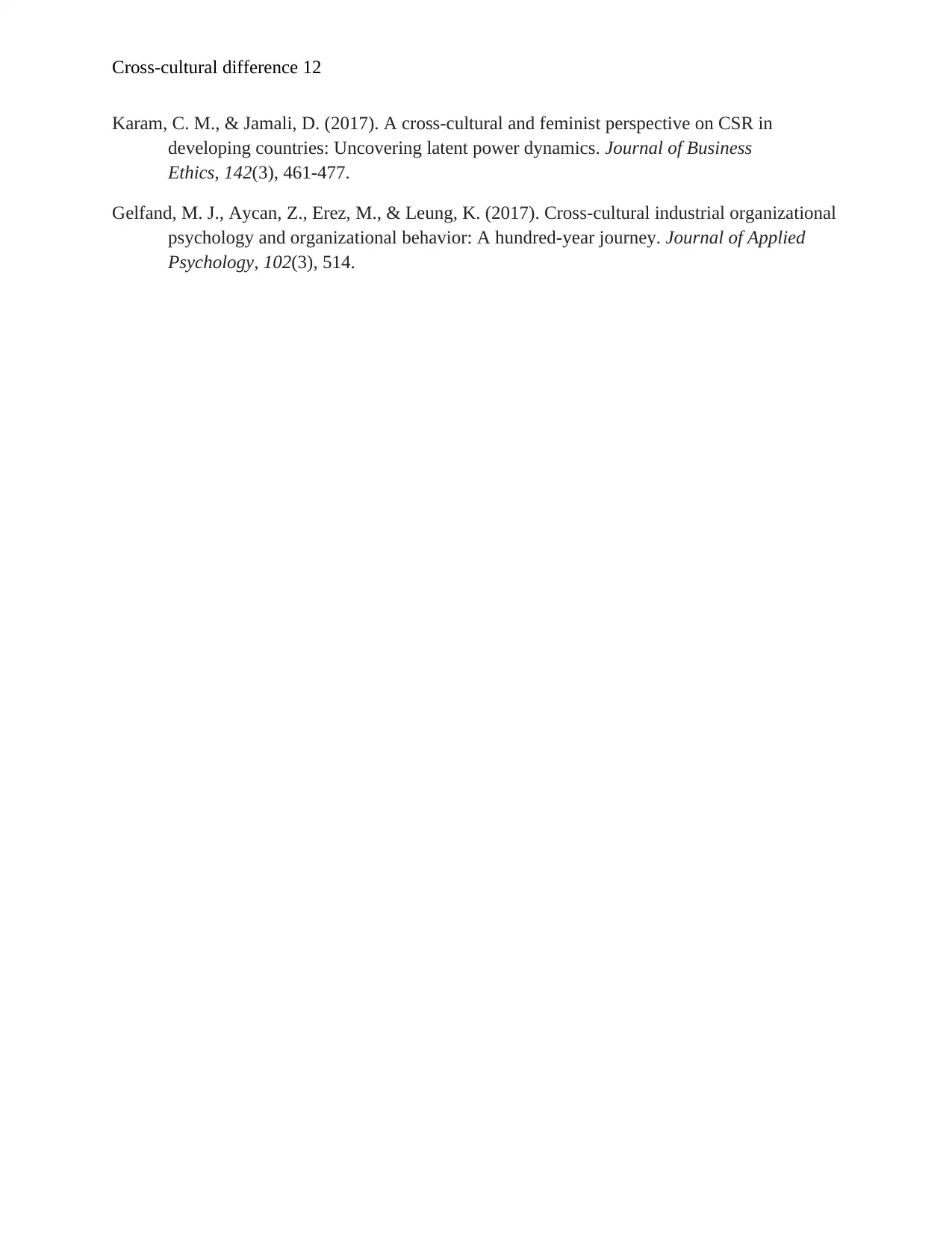
Cross-cultural difference 12
Karam, C. M., & Jamali, D. (2017). A cross-cultural and feminist perspective on CSR in
developing countries: Uncovering latent power dynamics. Journal of Business
Ethics, 142(3), 461-477.
Gelfand, M. J., Aycan, Z., Erez, M., & Leung, K. (2017). Cross-cultural industrial organizational
psychology and organizational behavior: A hundred-year journey. Journal of Applied
Psychology, 102(3), 514.
Karam, C. M., & Jamali, D. (2017). A cross-cultural and feminist perspective on CSR in
developing countries: Uncovering latent power dynamics. Journal of Business
Ethics, 142(3), 461-477.
Gelfand, M. J., Aycan, Z., Erez, M., & Leung, K. (2017). Cross-cultural industrial organizational
psychology and organizational behavior: A hundred-year journey. Journal of Applied
Psychology, 102(3), 514.
⊘ This is a preview!⊘
Do you want full access?
Subscribe today to unlock all pages.

Trusted by 1+ million students worldwide
1 out of 12
Related Documents
Your All-in-One AI-Powered Toolkit for Academic Success.
+13062052269
info@desklib.com
Available 24*7 on WhatsApp / Email
![[object Object]](/_next/static/media/star-bottom.7253800d.svg)
Unlock your academic potential
Copyright © 2020–2025 A2Z Services. All Rights Reserved. Developed and managed by ZUCOL.





